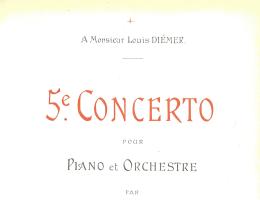Piano Concerto no. 5 in F major op. 103
1. Allegro animato – 2. Andante – 3. Molto allegro
Saint-Saëns had planned to travel to India and Vietnam in 1896, but when that project fell through, he opted for Egypt, where he had already spent several winter vacations. The land of the pharaohs influenced the flavour and material of the slow movement of his Concerto no. 5, op. 103. “The G-major section [marked Allegretto tranquillo quasi andantino] is a Nubian love-song that I have heard boatmen sing on the Nile,” Saint-Saëns declared. The Andante, he said, “takes us on a journey to the East and even, in the F-sharp passage, to the Far East”. But the exoticism he cultivated was deliberately superficial. The vociferous declamation of the first pages of the Andante is more reminiscent of Arabia (as Europeans then saw it) than of the Nubian song, westernised by its harmonisation and orchestration. In the first movement, in sonata form, the piano presents the two themes, the first one quite calm, with crystal-clear sonorities, the second one, in D minor, peppered with hemiolas and imbued with nostalgia. In the last movement Saint-Saëns brings together features we associate with his works: vigour and elegance, virtuosity, popular touches, subdued lyricism, instrumental dialogues based on a counterpoint that is never scholastic. The concerto was published with a dedication to the pianist Louis Diémer, but it was Saint-Saëns who gave the first performance, at the Salle Pleyel on 2 June 1896, with the orchestra of the Société des Concerts du Conservatoire conducted by Paul Taffanel. That day, at the age of sixty, Saint-Saëns celebrated the fiftieth anniversary of his first concert as a pianist.

